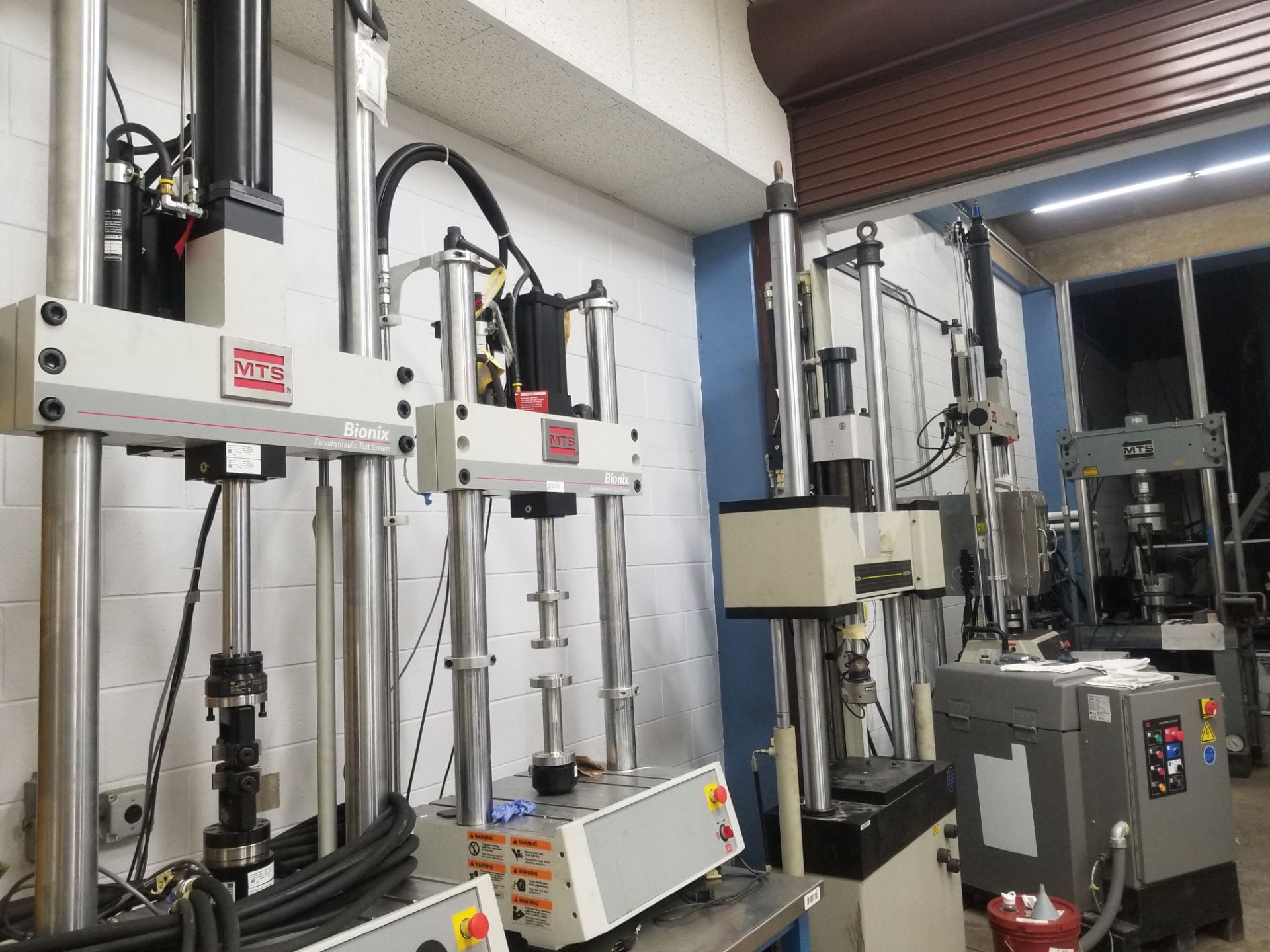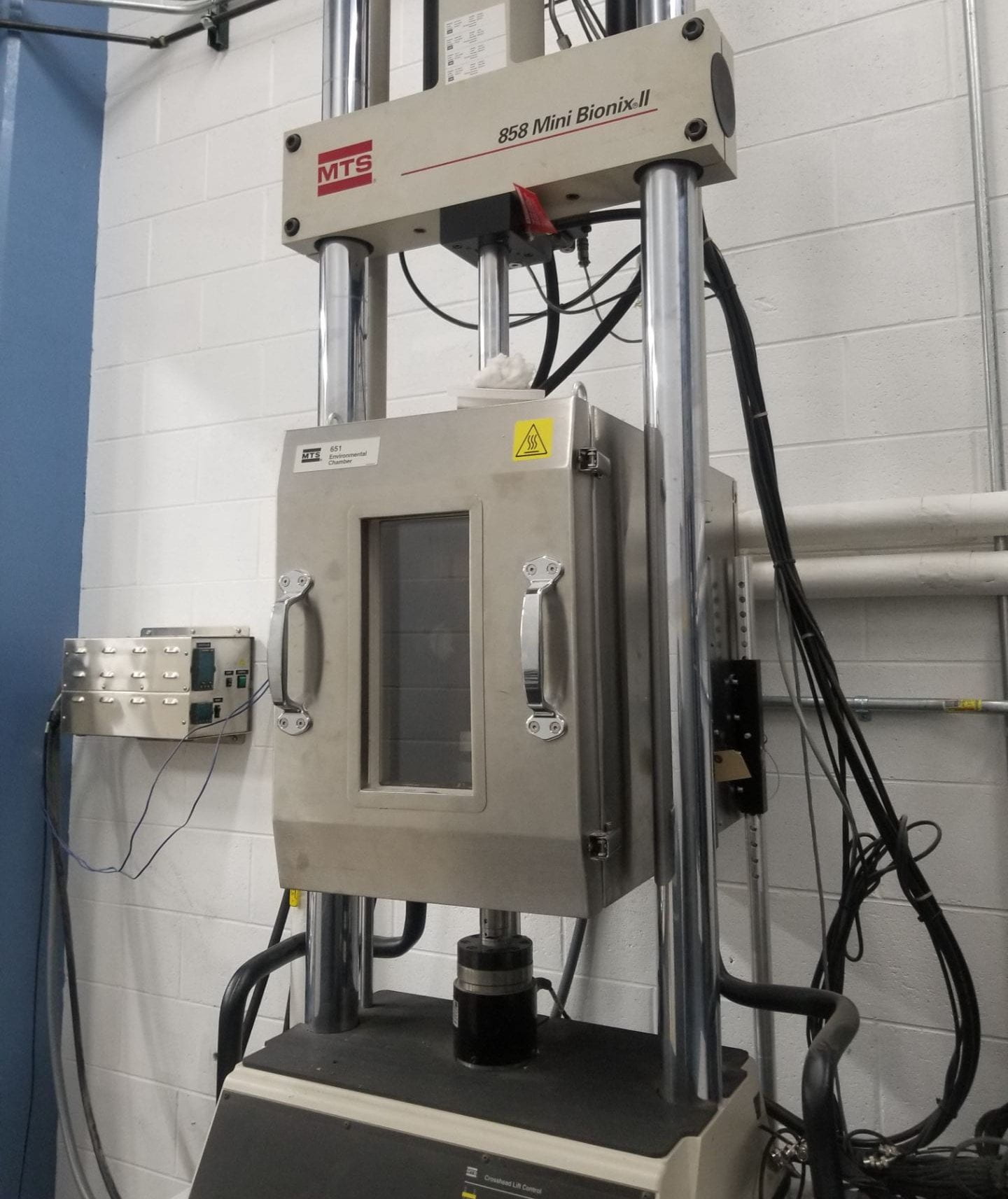

The UWM Structures Engineering Lab is one of very few structural labs in the United States that is ISO/IEC 17025 certified. This means that the equipment calibrations are up-to-date, and our testing methodologies and operations meet the strictest quality standards of ISO/IEC 17025. The facility is equipped with a variety of test machines, measuring instrumentation, sensors, and monitoring systems.
The Structural Engineering Laboratory, occupying approximately 5,100 square feet of primary floor space, has a main structural test area of 2,400 sq. ft (60 feet long and 40 feet wide) that is served by two 10-ton-capacity overhead cranes in a high-ceiling area. Tie-down locations are provided at 3-ft spacing throughout the structural floor area (strong floor). A load of 100,000 lbs. (tension or compression) can be applied at each tie-down point.
This facility also includes a large reaction wall for application of horizontal loads such as earthquake forces. Tie-down points at a spacing of 3 ft are also provided on the reaction wall. The strong floor for the structural laboratory consists of a story-high two-cell box structure. The cells (which are accessible from the basement and from a hatch on the lab floor) provide space for the installation of hydraulic pumps that feed the servo-hydraulic test machines. The basement cells also house special durability testing equipment. The strong floor tie-downs are also accessible from the basement.
The major test machines include:
- MTS 110-kip universal servo-hydraulic test machine with hydraulic grips for fatigue and static testing
- MTS 858 Mini Bionix (3.3 kip, 15 kN) axial and torsion test machine
- Four Instron 3369 (50 kN, 11-kip) electromechanical test machines
- Tinius Olsen 60-kip machine.
- Tinius Olsen 10-kip torsion test machine
- Instron 8802 (22-kip) axial test machine
- MTS 3.3-kip axial and torsion test machine
- MTS 3.3-kip axial test machine
- MTS 244.41 (110-kip) vertical actuator in frame
- MTS (20-kip) vertical actuator in frame
- Accelerated weathering test chamber
- Xenon test chamber

The structural laboratory has several servo-hydraulic actuators (up to 220 kips) that can be used to set up complex 3-D testing arrangements on the strong floor of the laboratory. Three hydraulic pumps (a 140 GPM, a 70 GPM, and a 10 GPM) are installed in the basement cell under the structural lab (with the requisite hoses and manifolds) to serve the servo-hydraulic test needs on the laboratory floor. Servocontrol modules and data acquisition systems are also available for such tests. Other hydraulic loading systems and hardware (including jacks, hoses, and pressure gages) are also available. These systems allow the application of static, dynamic and fatigue loadings on specimens ranging from small test coupons to 60-ft-long bridge beams.
Various types of sensors are available to measure structural response parameters. The facility is also equipped with other instrumentation such as dynamic analyzers, signal generators, and electronic systems for instrumentation. Various size and capacity load cells, displacement sensors (LVDTs and dial gages), and strain gages are also available for testing purposes.
The coatings laboratory within the UWM SEL has a QUV Accelerated Weathering Tester, a Q-SUN Xenon Test Chamber, and a cyclic corrosion test setup for recreating damage from full-spectrum sunlight and rain. A blasting cabinet for shot blasting of surfaces is also available. A LA abrasion machine, a custom pavement wear test machine, and freeze-thaw test equipment are housed in the basement cells.
Collaboration
UWM’s SEL team also works closely with the Concrete Laboratory and the Structural Durability Laboratory in UWM’s department of Civil and Environmental Engineering. We have access to a wide variety of aggregate, cement, and concrete related testing services as well as tests to determine long-term durability of construction materials including accelerated corrosion testing, chloride testing, and salt ponding tests of concrete structures as well as assessments of the effects of sealers, coatings, and overlays on concrete structures including bridges.






